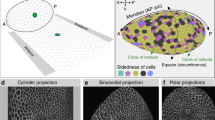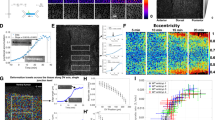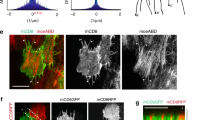Abstract
The morphogenesis of developing embryos and organs relies on the ability of cells to remodel their contacts with neighbouring cells. Using quantitative modelling and laser nano-dissection, we probed the mechanics of a morphogenetic process, the elongation of Drosophila melanogaster embryos, which results from polarized cell neighbour exchanges. We show that anisotropy of cortical tension at apical cell junctions is sufficient to drive tissue elongation. We estimated its value through comparisons between in silico and in vivo data using various tissue descriptors. Nano-dissection of the actomyosin network indicates that tension is anisotropically distributed and depends on myosin II accumulation. Junction relaxation after nano-dissection also suggests that cortical elastic forces are dominant in this process. Interestingly, fluctuations in vertex position (points where three or more cells meet) facilitate neighbour exchanges. We delineate the contribution of subcellular tensile activity polarizing junction remodelling, and the permissive role of vertex fluctuations during tissue elongation.
This is a preview of subscription content, access via your institution
Access options
Subscribe to this journal
Receive 12 print issues and online access
$209.00 per year
only $17.42 per issue
Buy this article
- Purchase on Springer Link
- Instant access to full article PDF
Prices may be subject to local taxes which are calculated during checkout







Similar content being viewed by others
References
Hutson, M. S. et al. Forces for morphogenesis investigated with laser microsurgery and quantitative modeling. Science 300, 145–149 (2003).
Keller, R. Mechanisms of elongation in embryogenesis. Development 133, 2291–2302 (2006).
Thomson, D. W. On Growth and Form (Cambridge University Press, New York; 1961).
Bertet, C., Sulak, L. & Lecuit, T. Myosin-dependent junction remodelling controls planar cell intercalation and axis elongation. Nature 429, 667–671 (2004).
Hayashi, T. & Carthew, R. W. Surface mechanics mediate pattern formation in the developing retina. Nature 431, 647–652 (2004).
Bao, S. & Cagan, R. Preferential adhesion mediated by Hibris and Roughest regulates morphogenesis and patterning in the Drosophila eye. Dev. Cell 8, 925–935 (2005).
Käfer, J., Hayashi, T., Marée, A. F., Carthew, R. W. & Graner, F. Cell adhesion and cortex contractility determine cell patterning in the Drosophila retina. Proc. Natl Acad. Sci. USA 104, 18549–18554 (2007).
Lecuit, T. & Lenne, P. F. Cell surface mechanics and the control of cell shape, tissue patterns and morphogenesis. Nature Rev. Mol. Cell. Biol. 8, 633–644 (2007).
Steinberg, M. S. Reconstruction of tissues by dissociated cells. Some morphogenetic tissue movements and the sorting out of embryonic cells may have a common explanation. Science 141, 401–408 (1963).
Steinberg, M. S. & Takeichi, M. Experimental specification of cell sorting, tissue spreading, and specific spatial patterning by quantitative differences in cadherin expression. Proc. Natl Acad. Sci. USA 91, 206–209 (1994).
Foty, R. A. & Steinberg, M. S. The differential adhesion hypothesis: a direct evaluation. Dev. Biol. 278, 255–263 (2005).
Graner, F. & Glazier, J. A. Simulation of biological cell sorting using a two-dimensional extended Potts model. Phys. Rev. Lett. 69, 2013–2016 (1992).
Farhadifar, R., Roper, J. C., Aigouy, B., Eaton, S. & Julicher, F. The influence of cell mechanics, cell–cell Interactions, and proliferation on epithelial packing. Curr. Biol. 17, 2095–2104 (2007).
Irvine, K. D. & Wieschaus, E. Cell intercalation during Drosophila germband extension and its regulation by pair-rule segmentation genes. Development 120, 827–841 (1994).
Blankenship, J. T., Backovic, S. T., Sanny, J. S., Weitz, O. & Zallen, J. A. Multicellular rosette formation links planar cell polarity to tissue morphogenesis. Dev. Cell 11, 459–470 (2006).
Ouchi, N. B., Glazier, J. A., Rieu, J. P., Upadhyaya, A. & Sawada, Y. Phys. A. 329, 451–458 (2003).
Cavey, M., Rauzi, M., Lenne, P. F. & Lecuit, T. A two-tiered mechanism for stabilization and immobilization of E-cadherin. Nature 453, 751–756 (2008).
Brodland, G. W. The differential interfacial tension hypothesis (DITH): a comprehensive theory for the self-rearrangement of embryonic cells and tissues. J. Biomech. Eng. 124, 188–197 (2002).
Zajac, M., Jones, G. L. & Glazier, J. A. Simulating convergent extension by way of anisotropic differential adhesion. J. Theor. Biol. 222, 247–259 (2003).
Mombach, J. C., Glazier, J. A., Raphael, R. C. & Zajac, M. Quantitative comparison between differential adhesion models and cell sorting in the presence and absence of fluctuations. Phys. Rev. Lett. 75, 2244–2247 (1995).
Graner, F., Dollet, B., Raufaste, C. & Marmottant, P. Discrete rearranging disordered patterns, part I: Robust statistical tools in two or three dimensions. Eur. Phys. J. E 25, 349–369 (2008).
Zallen, J. A. & Zallen, R. Cell-pattern disordering during convergent extension in Drosophila. J. Phys.: Condens. Matter 16, S5073–S5080 (2004).
Shraiman, B. I. Mechanical feedback as a possible regulator of tissue growth. Proc. Natl Acad. Sci. USA 102, 3318–3323 (2005).
Farge, E. Mechanical induction of Twist in the Drosophila foregut/stomodeal primordium. Curr. Biol. 13, 1365–1377 (2003).
Hufnagel, L., Teleman, A. A., Rouault, H., Cohen, S. M. & Shraiman, B. I. On the mechanism of wing size determination in fly development. Proc. Natl Acad. Sci. USA 104, 3835–3840 (2007).
Zajac, M., Jones, G. L. & Glazier, J. A. Model of convergent extension in animal morphogenesis. Phys. Rev. Lett. 85, 2022–2025 (2000).
Brakke, K. The surface evolver. Exp. Math 1, 41 (1990).
Oda, H. & Tsukita, S. Real-time imaging of cell–cell adherens junctions reveals that Drosophila mesoderm invagination begins with two phases of apical constriction of cells. J. Cell. Sci. 114, 493–501 (2001).
Cavey, M. & Lecuit, T. Imaging cellular and molecular dynamics in live embryos using fluorescent proteins. Methods Mol. Biol. 420, 219–238 (2008).
König, K. Multiphoton microscopy in life sciences. J. Microscopy 200, 83–104 (2000).
Kumar, S. et al. Viscoelastic retraction of single living stress fibers and its impact on cell shape, cytoskeletal organization, and extracellular matrix mechanics. Biophys. J. 90, 3762–3773 (2006).
Rasband, W. S. ImageJ, U. S. National Institutes of Health, Bethesda, Maryland, USA, http://rsb.info.nih.gov/ij/, 1997–2008.
Acknowledgements
We thank all the members of the Lenne and Lecuit labs for technical help, in particular M. Cavey and C. Bertet. We thank C. Bertet for Fig. 1c. We are grateful for D. Kiehart, H. Oda and C. Field for the gift of flies and antibodies. We thank everyone, especially Loic Le Goff for fruitful discussions during the course of this project. K. Brakke is acknowledged for help with Surface Evolver, F. Graner and A. Nicolas for insights and useful suggestions on the manuscript, and J. Axelrod, E. Munro, O. Pourquié and members of the Lenne and Lecuit labs for critical reading of the manuscript. Supported by the CNRS and an ANR-Blanc grant to T.L. and P.-F.L. M.R. is supported by a Bourse Région Entreprise (Amplitude Systems), and P.V. is supported by a Postdoctoral Fellowship from ANR.
Author information
Authors and Affiliations
Contributions
P.-F.L. and T.L. conceived and designed the project; P.-F.L., T.L., M.R. and P.V analysed the data; P.-F.L. and M.R. designed and built the set-up for nano-dissection experiments; M.R. performed the nano-dissection experiments; P.V. designed and wrote the image analysis tool with P.-F.L. and conducted the quantitative studies of germband elongation movies; P.-F.L. performed the simulations; P.-F.L. and T.L. wrote the paper; all authors read and edited the manuscript.
Corresponding authors
Ethics declarations
Competing interests
The authors declare no competing financial interests.
Supplementary information
Supplementary Information
Supplementary Information (PDF 1533 kb)
Supplementary Information
Supplementary Movie 1 (MOV 2982 kb)
Supplementary Information
Supplementary Movie 2 (MOV 2999 kb)
Supplementary Information
Supplementary Movie 3 (MOV 2909 kb)
Supplementary Information
Supplementary Movie 4 (MOV 710 kb)
Supplementary Information
Supplementary Movie 5 (MOV 2918 kb)
Rights and permissions
About this article
Cite this article
Rauzi, M., Verant, P., Lecuit, T. et al. Nature and anisotropy of cortical forces orienting Drosophila tissue morphogenesis. Nat Cell Biol 10, 1401–1410 (2008). https://doi.org/10.1038/ncb1798
Received:
Accepted:
Published:
Issue Date:
DOI: https://doi.org/10.1038/ncb1798
This article is cited by
-
Embryo mechanics cartography: inference of 3D force atlases from fluorescence microscopy
Nature Methods (2023)
-
Robust statistical properties of T1 transitions in a multi-phase field model of cell monolayers
Scientific Reports (2023)
-
Multiciliated cells use filopodia to probe tissue mechanics during epithelial integration in vivo
Nature Communications (2022)
-
Sculpting tissues by phase transitions
Nature Communications (2022)
-
Patterned mechanical feedback establishes a global myosin gradient
Nature Communications (2022)



